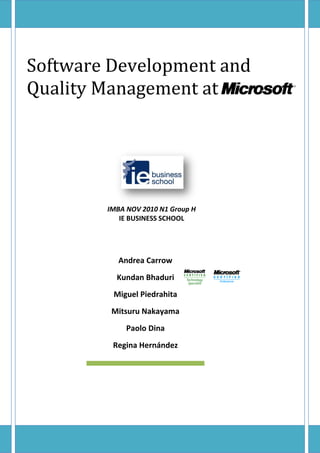
Software Development and Quality Management at Microsoft
- 1. Software Development and Quality Management at IMBA NOV 2010 N1 Group H IE BUSINESS SCHOOL Andrea Carrow Kundan Bhaduri Miguel Piedrahita Mitsuru Nakayama Paolo Dina Regina Hernández
- 2. Software Development and Quality Management at Microsoft Microsoft designs and delivers several lines of consumer and enterprise software products every year that form the core of its business. Each software product development process is considered a project and therefore has different sets of inputs, outputs and workflows. Further, the design process differs amongst product type (OS, ERPs, DTP applications, Database applications, Web Services etc). Each project is characterized by multi- member teams consisting of between 3 to 10 members per project, depending on the size of product (Small or Medium). However, it is not uncommon for larger projects to typically involve 100s of engineers and product specialists. Since skilled manpower form the key resource for each project, most projects at Microsoft are generally estimated with a buffer of 20-25% idle capacity. The Software design and development process is sub-divided into four sub-processes: Scope definition, Development, Stabilization and Delivery which have linear milestone-based sub-tasks (Exhibit 1). Although there are many software product development methods that have evolved at Microsoft over the past decade, one of the most prevalent ones is the Risk-Requirement based development methodology. In this process, at the time of scope definition and requirement design, all pertinent risks to the project are identified and associated to one or more requirements in what is known as a Risk-Requirement Matrix (Exhibit 2). At the end of development, this matrix is used to prioritize testing for those requirements that had the highest risk associated to them, thus mitigating these risks. This method ensures product quality with lower effort and cost. Microsoft observes three quality goals in all its software development projects – Functionality, performance and timeliness of delivery. The key quality issues that are commonly experienced are low reliability, high interoperability costs, and low scalability. These can be attributed to various bottlenecks arising out of interdependence of various systems and modules. Microsoft also identifies its Software Quality Gap, which is defined as the deviance between the result of quality delivered and the combined expectation of the software producer and the customer. These gaps are mitigated through managed development methods such as Joint Application Development (JAD) at Microsoft. The key metrics that are used to benchmark software quality at the company are explained in Exhibit 3. In its very basic form, the software development process is nothing but an assimilation of inputs in terms of user requirements that are transformed into usable software programs. The process has many subdivisions and therefore several intermediate outputs get generated throughout the process of software development. The key principle assumed in this process is that the resources are able to meet the schedule and process the deliverable. Project Management is therefore a key aspect in the software development process. Project managers frequently use planning and quality tools such as Microsoft Project Plan (MPP) and Quick Test Pro (QTP) to track resource utilization, identify bottlenecks, generate cost estimations and track revenues. Microsoft uses several key ratios to track efficiency of their development and quality assurance processes. The two widely used ratios are Defect Leakage Rate (DLR) and the Defect Rejection Rate (DRR) (Exhibit 4). At an overall level, for every defect in the system at the 3 quality level (i.e. 3 defects per 1000 lines of code [LOC]), on an average 37.5% defects get leaked into production. It is therefore clear that early detection and resolution of defects is critical for Microsoft to keep its costs low. Therefore it is important that the company makes the right tradeoff between Costs and Quality (COQ) during the software development process (Exhibit 5). The company also adopts a lean Quality Control process throughout its development cycle. The process begins by allocating a severity and priority to all identified defects. The severity is based on the defect’s importance to the technical implementation, while the priority of a defect signifies its importance to business requirement conformance. Only upon resolution of all high severity and high priority defects, is any product released to market after iterative testing (Exhibit 6). However, we all know from our experience that zero-defect-release has always been elusive for Microsoft. Some permutations of inputs that result in ‘bugs’ get potentially leaked through the testing cycle, and creep into production release (but get subsequently detected by the consumers due to a large install base). Over the past four years, Microsoft has consistently focused on decreasing its DLR, which has shown impressive results. While the Vista operating system had a very high DLR (upwards of 10%), the company’s most successful OS till date, Windows 7, introduced in 2010 enjoys a DLR of <1% (while improving the process quality to 6 ) thanks to improved control systems in the company. In conclusion, right quality assurance practices can help reduce development & maintenance costs and lower customer dissatisfaction, which in turn drives sales. Microsoft is a perfect case in point in this direction. © IE Business School | Operations Management T2 Final Project | IMBA Nov 2010 N1 Group H 1
- 3. Software Development and Quality Management at Microsoft Requirement Risks Q1 R1 Q2 R2 Q3 R3 Q4 R4 Requirement Q5 is not tested, Q5 since no risks are associated Exhibit 1: Software Development Process Exhibit 2: Risk-Requirement Quality Assurance Method Functionality: Correctness, completeness, security and timeliness. Usability: User-friendliness, availability, suitability, adaptability. Reliability: Resilience, Recovery, Degradation, Transfer Performance: Speed, Economy Supportability: Testability, Maintainability, Portability, Manageability Exhibit 3: Software Quality Metrics Exhibit 4: Important Quality Ratio used at Microsoft Total Cost of Quality High Microsoft’s sweet (TCQ) spot COST Cost of implementing Defects Cost of rectifying Low Defects Low QUALITY High Exhibit 5: Cost of Quality and point of equilibrium Exhibit 6: Defect Prioritization System © IE Business School | Operations Management T2 Final Project | IMBA Nov 2010 N1 Group H 2
